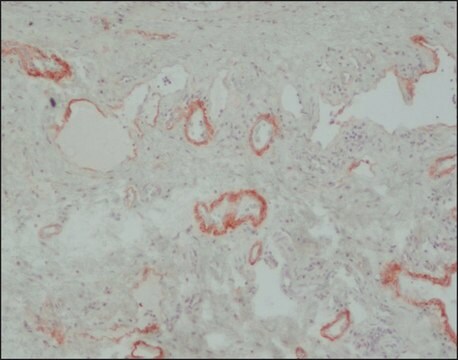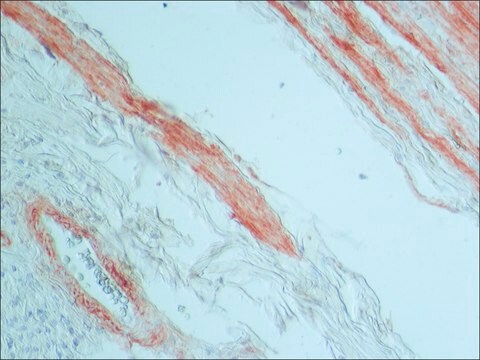推薦產品
生物源
rat
品質等級
共軛
unconjugated
抗體表格
ascites fluid
抗體產品種類
primary antibodies
無性繁殖
MTn-12, monoclonal
包含
15 mM sodium azide
物種活性
mouse
技術
immunohistochemistry (frozen sections): suitable
immunoprecipitation (IP): suitable
indirect ELISA: suitable
indirect immunofluorescence: 1:200 using unfixed, frozen tissue sections of mouse intestine
western blot: suitable
同型
IgG1
UniProt登錄號
運輸包裝
dry ice
儲存溫度
−20°C
目標翻譯後修改
unmodified
基因資訊
mouse ... Tnn(329278)
一般說明
Monoclonal Anti-Mouse Tenascin (rat IgG1 isotype) is derived from the MTn-12 hybridoma1 produced by the fusion of rat myeloma cells and splenocytes from a Lou rat immunized with partially purified mouse tenascin. Human tenascin has three subunits of 190, 200 and 220 kDa. Tenascin has been independently discovered in a variety of species and tissue types, often in the basement membrane or intercellular spaces. It has been described under a variety of names: cytotactin, hexabrachion protein, J1, myotendinous antigen (MI) and glioma mesenchymal extracellular matrix (GMEM). The tenascin molecule is a disulfide-linked hexamer, depending on species, the molecular weights of the subunits range from 190 to 320 kDa.
Tenascin is a high molecular weight, multifunctional, extracellular matrix glycoprotein expressed in association with mesenchymal-epithelial interactions during development and in the neovasculature and stroma of undifferentiated tumors. It has been described under a variety of names: cytotactin, hexabrachion protein, J1, myotendinous antigen (MI) and glioma mesenchymal extracellular matrix (GMEM).
The tenascin molecule is a disulfide-linked hexamer; depending on species, the molecular weights of the subunits range from 190 to 320 kDa. In the mouse, two major subunits of tenascin with an apparent molecular weight of 210 and 260 kDa have been described. The shorter polypeptide predominates during earlier developmental stages and the larger polypeptide appears later in the embryonic gut and especially in the adult intestine. The expression of tenascin is associated with development and growth, both normal and pathological, whereas the distribution in normal adult tissue is restricted. It was proposed that actively growing, migrating and differentiating epithelial sheets can produce factors that can stimulate tenascin expression in the nearby mesenchyme. Human and chicken tenascin contain an RGD sequence which may function in cell adhesion and it seems likely that tenascin mediates cell attachment through an RGD dependent integrin receptor.
The tenascin molecule is a disulfide-linked hexamer; depending on species, the molecular weights of the subunits range from 190 to 320 kDa. In the mouse, two major subunits of tenascin with an apparent molecular weight of 210 and 260 kDa have been described. The shorter polypeptide predominates during earlier developmental stages and the larger polypeptide appears later in the embryonic gut and especially in the adult intestine. The expression of tenascin is associated with development and growth, both normal and pathological, whereas the distribution in normal adult tissue is restricted. It was proposed that actively growing, migrating and differentiating epithelial sheets can produce factors that can stimulate tenascin expression in the nearby mesenchyme. Human and chicken tenascin contain an RGD sequence which may function in cell adhesion and it seems likely that tenascin mediates cell attachment through an RGD dependent integrin receptor.
特異性
The antibody localizes mouse tenascin in the supernatant of cultured mouse fibroblasts and tissue extracts. No cross-reactivity with tenascin of other species has been observed. In immunohistological testing of frozen tissue sections of mouse intestine, the antibody labels the core of the villi, but not the epithelial cells.
免疫原
partially purified mouse tenascin.
應用
Applications in which this antibody has been used successfully, and the associated peer-reviewed papers, are given below.
Immunohistochemistry (1 paper)
Immunohistochemistry (1 paper)
Monoclonal Anti-Mouse Tenascin antibody may be used for the localization of tenascin and to study of the role of tenascin in epithelial-mesenchymal interactions using various immunochemical assays including ELISA, immunoblot, dot blot and immunohistology.
Monoclonal Anti-Tenascin antibody produced in rat has been used in:
- Enzyme linked immunosorbent assay (ELISA)
- Dot blot.
- Immunoblotting
- Fluorescence microscopy and immunostaining
- Immunofluorescence
- Immunohistochemistry
生化/生理作用
Tenascin is a high molecular weight, multifunctional, extracellular matrix glycoprotein expressed in association with mesenchymal-epithelial interactions during development and in the neovasculature and stroma of undifferentiated tumors. The expression of tenascin is associated with development and growth, both normal and pathological, whereas the distribution in normal adult tissue is restricted. It was proposed that actively growing, migrating and differentiating epithelial sheets can produce factors that can stimulate tenascin expression in the nearby mesenchyme. Human and chicken tenascin contain an RGD sequence motif which may function in cell adhesion and may be recognized by integrin receptor.
免責聲明
Unless otherwise stated in our catalog or other company documentation accompanying the product(s), our products are intended for research use only and are not to be used for any other purpose, which includes but is not limited to, unauthorized commercial uses, in vitro diagnostic uses, ex vivo or in vivo therapeutic uses or any type of consumption or application to humans or animals.
Not finding the right product?
Try our 產品選擇工具.
儲存類別代碼
10 - Combustible liquids
水污染物質分類(WGK)
nwg
閃點(°F)
Not applicable
閃點(°C)
Not applicable
分析證明 (COA)
輸入產品批次/批號來搜索 分析證明 (COA)。在產品’s標籤上找到批次和批號,寫有 ‘Lot’或‘Batch’.。
Clinical impact and functional aspects of tenascin-C expression during glioma progression
Herold-Mende C, et al.
International Journal of Cancer. Journal International Du Cancer, 98(3), 362-369 (2002)
Transgenic overexpression of the alpha7 integrin reduces muscle pathology and improves viability in the dyW mouse model of merosin-deficient congenital muscular dystrophy type 1A
Doe JA, et al.
Journal of Cell Science, 124(13), 2287-2297 (2011)
Developmental changes in patterns of expression of tenascin-C variants in the human cornea
Maseruka H, et al.
Investigative Ophthalmology & Visual Science, 41(13), 4101-4107 (2000)
The Expression and Possible Functions of Tenascin-W During Development and Disease
Tucker RP and Degen M
Frontiers in Cell and Developmental Biology, 7, 53-53 (2019)
Isabelle Louis et al.
Blood, 102(4), 1397-1404 (2003-04-19)
Oncostatin M (OM) transforms the lymph node (LN) into a "super lymphoid organ" with 2 striking features: massive thymus-independent T-cell development and major expansion of the memory T-cell pool. We report that T-cell development in the LckOM LN is regulated
我們的科學家團隊在所有研究領域都有豐富的經驗,包括生命科學、材料科學、化學合成、色譜、分析等.
聯絡技術服務








